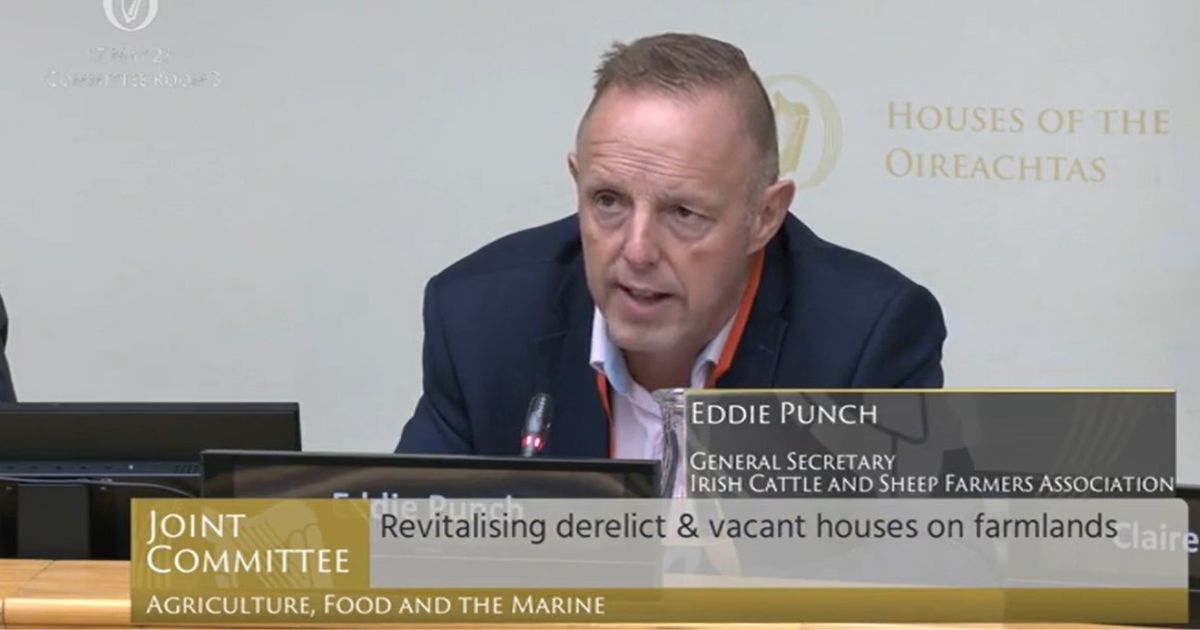ICSA Statement to Oireachtas Committee for Agriculture on Revitalising Derelict and Vacant Houses on Farmland:
The discussion on Revitalising Derelict and Vacant Properties on Farmland is linked to the recent announcement of new terms and conditions, and grant ceilings, under the Vacant Property Refurbishment Grant (Croí Cónaithe Fund).
In principle ICSA strongly welcomes the changes which have come into effect on 1 May 2023.
Context:
There is a housing crisis in Ireland which has been the subject of numerous Dail debates and public discussion.
The main issue is that we are simply not building enough housing units to cater for an expanding population.
The CSO preliminary census results for 2022 indicate a population of 5.1 million, a 7.6% increase since 2016 and an increase of 1.2 million over the 2002 level of 3.932 million. The 2022 census also indicates a 6% increase in housing stock since 2016 so the available housing stock has not kept pace with the population growth.
The prolonged Covid lockdown, which closed building sites, is certainly a contributory factor but it would be misleading to say that it was the sole reason why housing is not keeping pace with population growth. The financial crash led to a lot of skilled building workers returning to their home countries. We swung from excess credit to too little credit at that time. In recent years, building costs rocketed and a significant cause has been Chinese demand for raw materials.
Nevertheless, there has been some improvement in housing delivery with 29,851 new homes completed in 2022. This is well below the boom years where over 93,000 homes were completed in 2006, and while we don’t necessarily want to return to the excess of that period, it is clear that we need to build significantly more homes than current levels.
Recent weeks have seen discussions around accommodation problems in relation to refugees. The CSO’s most recent estimate is that we have welcomed some 75,000 Ukraine refugees because of the horrific war caused by the Russian invasion. However, there are significant levels of asylum seekers from many other countries and there is also a question mark about whether we have accurate figures for economic migrants who initially come here to study English or perhaps to work, but who manifestly have an impact on the demand for housing as well. Regardless of the debate about hotel accommodation, it is unarguable that all of this means we need multiple strategies to increase housing well in excess of 30,000 units per annum.
A feature of the debate has been the allegation that we have many vacant properties which could and should be brought back into use.
What is the role of Rural Ireland in contributing a solution to the housing crisis?
The 2022 census preliminary results indicate a housing stock of 2,124, 590 homes. It calculates 66,135 holiday homes and 166,752 vacant houses and apartments. Of this latter figure, farmhouses were estimated to account for 12,334 units.
So clearly there is some potential there to provide additional housing. A key point is that the method used to arrive at these figures is the inability of census enumerators to find any occupiers. It is likely, in our view, that the census enumerators would not have included a significant amount of derelict or remotely located properties. Clearly, they would not have sought occupants for a derelict ruin or house with the roof in bad repair.
Of course, it is the case that many of the 166,752 properties are temporarily unoccupied and their status, based on the one night of the census, is evidently misleading. A more meaningful indicator may be the CSO statistic which says that 48,387 vacant units were also vacant in 2016.
The conundrum is whether vacant properties in rural areas coincide with the demand for housing. The housing shortage is most acutely felt in large urban centres, and this is reflected in rental costs in Dublin.
This does not mean that there is no demand in the provinces. The biggest increase in population in the 2022 census on a county basis was in Longford, at 14.1%, followed by Meath at 13%. Leitrim’s population increased by 10% but its housing stock only increased by 3%. And although many immigrants gravitate towards urban areas for access to work, education, and services, it is also true that many immigrants – Brazilians are a good example – are happy to locate in more rural areas.
In any event, the ongoing demand by natives of rural communities for planning to live close to the communities they grew up in demonstrates that rural housing has to be part of the solution. The alternative is for those rural natives to move to cities and towns thereby exacerbating the problem.
New Grant for Vacant or Derelict Properties
The new scheme provides for grants up to €50,000 for vacant properties and up to €70,000 for derelict properties.
At first examination, this is a good level of grant aid. However, there are some misgivings in relation to renovating any property under this programme including those on farmland.
- While the grant rate is reasonably large, the cost of renovating properties is likely to be substantially more, especially in the case of derelict properties.
- Derelict properties are likely to cost €150,000 and upwards depending on size to renovate and these kinds of properties are difficult to accurately cost at the outset.
- The documents indicate the maximum grant may be payable for 3-beds and there is a lack of clarity around smaller units (i.e., 2-bed or 1-bed).
- A condition of the scheme is that units must be either owner-occupied or for rent and this is a welcome change from the previous scheme which was limited to owner-occupied only.
- However, the requirement is that a property must be rented or owner-occupied.
for 10 years after completion. This is understandable, but there must be flexibility for unforeseen circumstances because the penalty is the return of the full grant amount if the condition is not met for at least 5 years, and 75% clawback if it happens after 5 years but less than 10 years. This is an onerous condition and could deter some.
- The scheme requires a legal charge over the property for 10 years (in favour of the relevant local authority) and ICSA would regard this as excessive.
- The legal charge will be second in priority to the bank’s legal charge if the applicant has taken a mortgage to purchase the property.
- It is not clear how many cases this will apply to because ICSA understands that banks will not normally lend to buy derelict properties other than those that are incidental to a bigger transaction (e.g., farmland purchase).
- Moreover, there is lack of clarity as to what the position is regarding priority on collateral in the case of a loan to do the works. In the event that a lending institution was minded in principle to fund the renovation costs, would this be undermined by the local authority charge?
- In practice, ICSA understands that it is next to impossible to achieve bank finance over an appropriate timeframe (15-20 years) or even a shorter period for the renovation of a derelict property on farmland or anywhere else.
- The Government needs to engage with lending institutions to ensure that finance is available; otherwise, the potential of the scheme will remain largely unrealised save for a minority who can fund such developments out of their own funds.
- The taxation treatment of subsequent renting needs to be looked at. Regardless of whether there are bank repayments or not, most who might avail of this scheme, particularly on farmland, will be confronted with tax takes in excess of 50% on rental income and this will be a big barrier to delivering on the scheme.
- ICSA suggests that USC should not apply to rental properties held by small scale landlords (owning 10 properties or less) or that alternatively, all renovation costs net of grant should be fully allowable as a capital allowance over seven years against income tax, PRSI and USC.
- The scheme requires full completion of the works within 13 months of the approval letter. This is far too tight, given the scarcity of builders, the likelihood of unforeseen engineering and other building problems (much more likely on derelict properties) and possible cash-flow problems in the absence of suitable loan options.
- It is very important that the scheme does not become unattractive or unworkable due to excessive requirements under planning or under the scheme itself, in terms of spec, standards, energy efficiency, landscaping or other subjective aesthetic conditions. Some of the properties in question may be listed buildings and this cannot be overcome but many others may have traditional character and features. While it may be desirable to preserve this, it is vital that a pragmatic view is taken, and that excessive cost or delay is not imposed on projects.
- Local authorities should take a helpful role in allowing projects to proceed where planning is, on the face of it, not required. For example, the renovation of a building which involves no external change to the size of the building and where the building is not adjacent to third parties.
Specific Problems regarding properties on farmland
- Some properties on farmland may have been derelict for many years or may have been re-purposed for farming activities (e.g., storage of tools, calf housing). It is vital that local authorities proactively support the re-use of such properties for housing.
- The 10-year requirement to rent out the property may be particularly onerous for an on-farm dwelling and some leeway needs to be in place to cater for a child returning home to farm for example.
- Some farmers will be reluctant to have strangers on the farm and this is understandable. Lack of clarity around insurance (e.g., tenants walking on farmland) may be a barrier and as been pointed out by ICSA in numerous other contexts, the risk of being sued for compensation is still not satisfactorily dealt with.
- General rules around landlord-tenant arrangements are too onerous and increasingly too weighted in favour of the tenant. In the case of tenants moving in to a dwelling close to a farmer’s house and farmyard, this gives rise to concerns. For example, a repeated instance of a tenant (or their children) straying into farmyards or fields where their safety cannot be guaranteed. There is no provision for the farmer to decide that in this case, the tenancy needs to be ended and the RTB is not likely to be sympathetic. This needs to be looked at.
- We need to look again at ensuring that people who move to live in the countryside do not have the right to object or complain about normal farming activity, whether that be the sound of milking machines and silage harvesters or the aroma of silage and slurry.
Conclusion
In general, ICSA welcomes the scheme, and we believe that there are some properties that could be re-purposed on farmland. However, the major barriers are possible too much bureaucracy around planning and grant approval; an unrealistic time limit for completion of works; lack of bank finance; excessive taxation of the small landlord and concerns around insurance and the rights of the farmer as a landlord. If these issues are addressed, it can contribute to alleviating the housing crisis.
ENDS







